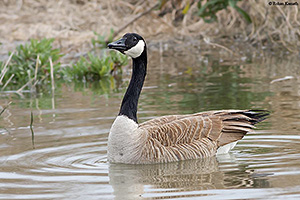How Long Can Birds Live? |
|||||||||||||||||||||||||||||||||||||||||||||||||||||||||||||||||||||||||||||||||||||||||||||||||||||||||||||||||
|---|---|---|---|---|---|---|---|---|---|---|---|---|---|---|---|---|---|---|---|---|---|---|---|---|---|---|---|---|---|---|---|---|---|---|---|---|---|---|---|---|---|---|---|---|---|---|---|---|---|---|---|---|---|---|---|---|---|---|---|---|---|---|---|---|---|---|---|---|---|---|---|---|---|---|---|---|---|---|---|---|---|---|---|---|---|---|---|---|---|---|---|---|---|---|---|---|---|---|---|---|---|---|---|---|---|---|---|---|---|---|---|---|---|
 photograph of a Canada Goose by Rohan Kamath |
Precise information on the longevity of birds is not easy to come by. It is usually impossible to follow large groups of individuals from hatching to death, so in addition to collecting data directly by banding and recapturing individuals, many indirect methods of estimating age are used. Generally, it appears that the heaviest post-fledging mortality occurs among inexperienced young birds, and that for adults, after they have successfully reared young, the probability of death each year remains roughly constant. In other words, few birds die of "old age -- they just run the same gamut of risks year in and year out until they are killed. The annual risk of being killed varies from about 70 percent in small temperate-zone songbirds (adult life expectancy about 10 months; in the tropics adult songbirds are thought to be much longer-lived) to 3 percent in Royal Albatrosses (fife expectancy slightly over 30 years). If a bird | ||||||||||||||||||||||||||||||||||||||||||||||||||||||||||||||||||||||||||||||||||||||||||||||||||||||||||||||||
| lasts long enough,
however, the probability of it dying
in a given year may once again rise. Common Terns reach old
age after about 19 years, and their annual risk of dying
then goes up. Life expectancy in birds is closely correlated with size -- the larger the species, the longer it is likely to live. But the relationship is far from exact. Some groups of birds tend to have long lives for their sizes, especially the Procellariiformes (tubenoses -- albatrosses, shearwaters, and petrels) and Charadriiformes (shorebirds, gulls and terns, and auks). Other groups, for instance titmice and chickadees, wrens, and game birds, are shorter-lived than their sizes would predict. Birds can be very long-lived in captivity. One Sulphur-crested Cockatoo (a common Australian parrot made famous by the TV show "Baretta") lived most of his 80-plus years in a zoo. Captive Canada Geese have lived for 33 years, House Sparrows 23 years, and Northern Cardinals 22 years. In nature, the life-spans of these species are much shorter. As luck would have it, however, the record for a European Starling in the wild, 20 years, is 3 years longer than for any starling captives. The table below gives longevity records (years-months) of wild birds. Small differences among these figures should not be taken too seriously. For one thing, they represent the upper end of a range -- and the range of any measurement is a statistic that almost always increases with the number of measurements. If, for instance, you record the heights of a random sample of 10 American women, and then of another sample of a million American women, both the tallest and the shortest woman are virtually certain to be in the larger sample. So the minimum life-spans of bird species that are frequently banded are more likely to be greater than those of species rarely banded, everything else being equal. It seems likely, for example, that the short record for the Northern Shrike is simply a result of a low frequency of banding. At any rate, remember that with the exception of efforts that may later be corrected, the numbers on the list can only increase. Remember also that these figures are maximum recorded ages. While at one point the maximum record for the Purple Finch was 10 years (it has since been extended to almost 12), of 1,746 recoveries from 21,715 banded individuals, only I lived 10 years, 6 lived 8 years, and 18 lived 7 years. All the remainder lived less than 7 years. In short, the maximum life-span is far longer than the median life-span (the length of the life of the individual that lives longer than half the population and shorter than the other half), which in songbirds is usually only a year or two.
Recent work on seabirds by ornithologist Ralph Schreiber of the Los Angeles County Museum indicates that dramatic increases in longevity records of seabirds can be expected as more data are gathered. For example, there are now thousands of banded Laysan Albatrosses that are in their 30s. It is likely that these and some others will eventually be shown to have life-spans of 50-70 years, longer than those of the rings used to band them! The records presented in our list are from Dr. M. Kathleen Klimkiewicz of the Bird Banding Laboratory of the U.S. Fish and Wildlife Service (with the exception of the Broad-tailed Hummingbird, which is courtesy of Dr. William Calder). They are updated to September 1, 1986. Records for all North American species may be found in three papers by Dr. Klimkiewicz and her colleagues published in the Journal of Field Ornithology. Updates of the records in the earlier papers will appear in the same journal. |
|||||||||||||||||||||||||||||||||||||||||||||||||||||||||||||||||||||||||||||||||||||||||||||||||||||||||||||||||
| SEE:
Population Dynamics. Copyright ® 1988 by Paul R. Ehrlich, David S. Dobkin, and Darryl Wheye. |
|||||||||||||||||||||||||||||||||||||||||||||||||||||||||||||||||||||||||||||||||||||||||||||||||||||||||||||||||